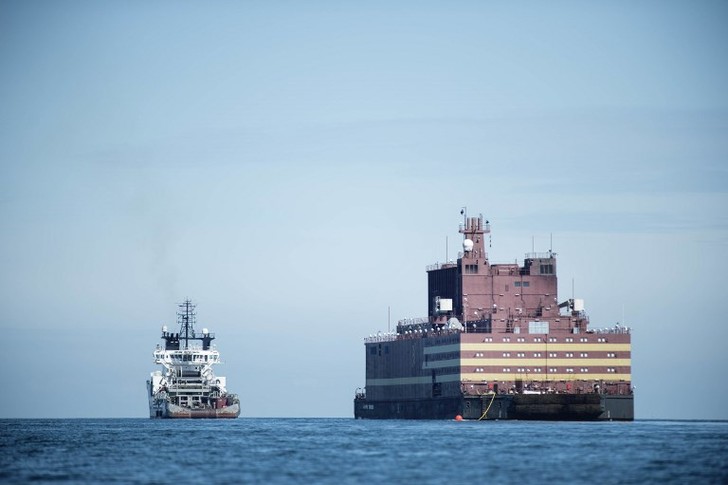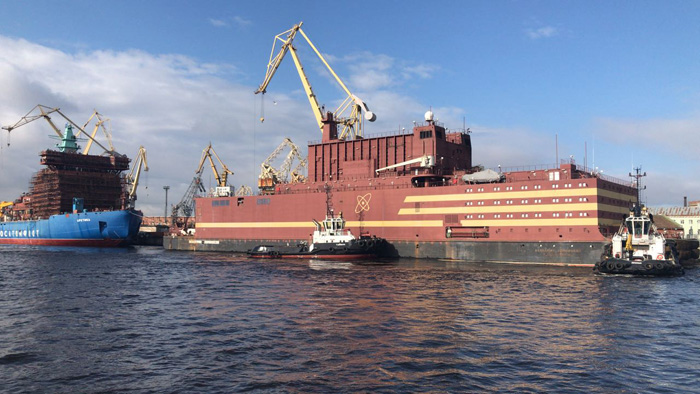Russia has launched Akademik Lomonosov, a floating nuclear power plant. The barge arrived in the port of Murmansk on Saturday, May 19, before joining the polar city of Pevek, where it will provide heating, electricity and industrial energy.
The Russian energy company Rosatom certifies the safety of its floating plant, while the Greenpeace association denounces the risk-taking.
Launched on April 28, 2018 at the shipyard of St. Petersburg (north-western Russia, at the bottom of the Baltic Sea), barge Akademik Lomonosov (1) arrived on Saturday, May 19 in the Russian port of Murmansk (north, on the Barents Sea), where its two reactors will be loaded with fuel (uranium) and tested in the autumn.
The floating platform will then be transported 5,000 km away to Pevek, the main port of the East Siberian Sea in the Russian Far East. The machine is expected to begin the second part of the trip in the summer of 2019, because like many other Russian nuclear projects, this project took at least two years late.
Strategically located, Pevek is located almost at the northeastern end of the immense Russia, on the famous north-east passage connecting the Atlantic Ocean and the Pacific Ocean and which, with global warming, should no longer have pack ice in winter.
 A mobile power station
A mobile power station
The plant is expected to start producing electricity in the summer of 2019. It can supply electricity to a city of 200,000. But in Pevek, it should provide power for both housing and for oil and gas platforms.
Akademik Lomonosov will replace the former Bilibino nuclear power plant (four uranium-graphite reactors each producing 12 MWe and built in 1974), the world’s northernmost nuclear power plant, and the Chaunsk coal-fired power plant, built in 1961.
One of the advantages of this type of nuclear power plant seems to be the mobility and speed of installation, thus avoiding the high cost of ground or air transport, piece by piece, in remote areas.
A miniaturized reactor for isolated regions
Developed by the Russian state-owned company Rosatom, this 144 m long and 30 m wide floating plant is equipped with two 35 MW KLT-40C reactors. Installed electric power much lower than that of the French pressurized water plants of 900 or 1 450 MW. This technology of small floating reactors is, according to the designer, effective in supplying hard-to-reach areas with electricity and heat.
In addition, these small reactors can operate continuously, without having to source fuel, for three to five years, which would significantly reduce the cost of generating electricity. Their lifespan should be 40 years, extendable up to 50 years. And Rosatom’s engineers are already working on a second generation floating plant, which will ship two 50 MW reactors.
Safe engineering or reckless risk taking?
On the Russian side, Rosatom says the floating reactor is “invincible” for tsunamis and other natural disasters. It also ensures that it meets all the requirements of the International Atomic Energy Agency (IAEA), based in Vienna, Austria, and is completely harmless to the environment.
According to her, the Akademik Lomonosov project relies on tested reactors aboard Russian submarines and nuclear icebreakers. It also took into account the findings of the Kursk accident , a nuclear submarine that, after explosions, sank in the Barents Sea in 2000, killing 118 people but whose reactor was found intact. during the bailout in 2001.
Yet many environmental groups such as the Russian NGO Bellona led by environmentalist Alexander Nikitin, former officer, or Greenpeace who speaks of “floating Chernobyl” or “nuclear Titanic” , as well as the governments of Norway, Sweden and Finland, do not seem reassured by this project.
Greenpeace denounces the absence of containment in the event of an accident, a point that Thierry Charles, engineer and deputy director general of the Institute for Radiation Protection and Nuclear Safety (IRSN), considers however manageable given the smallness of these reactors.



